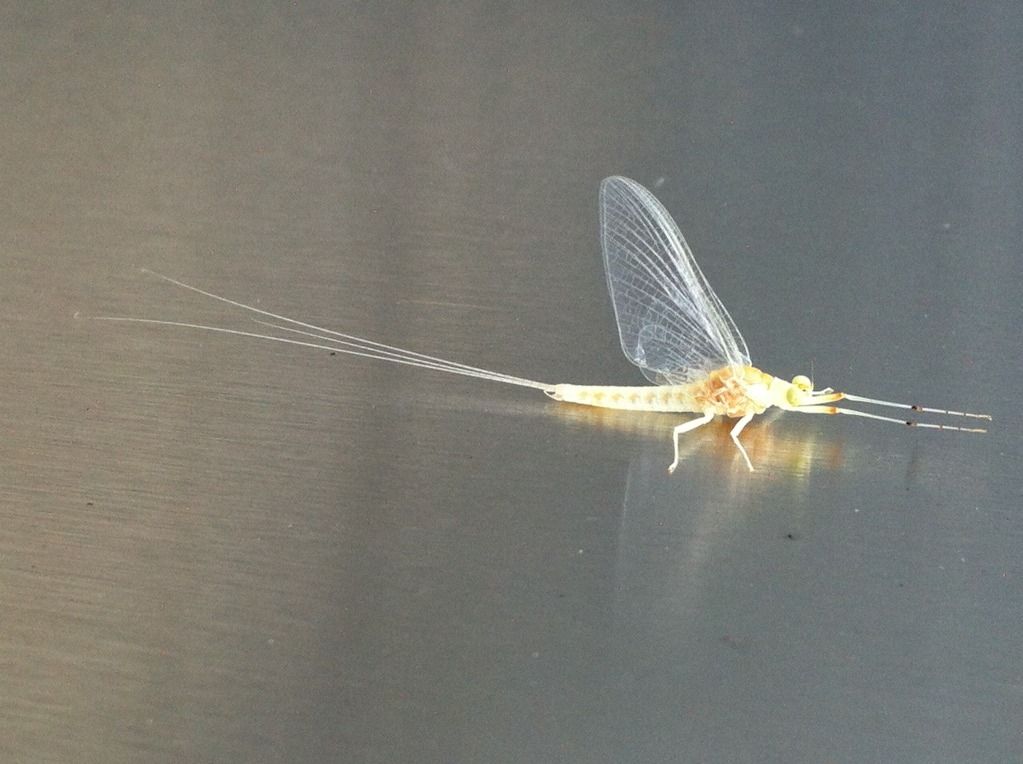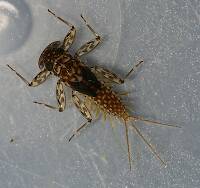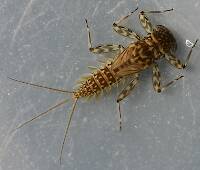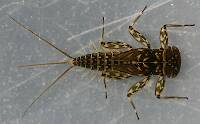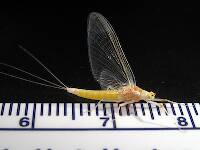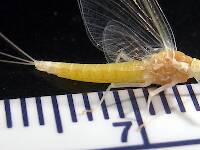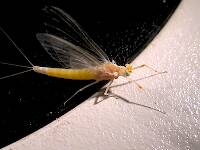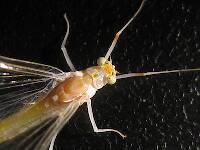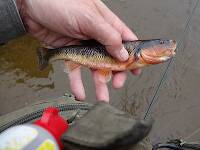
Hex Mayflies
Hexagenia limbata
The famous nocturnal Hex hatch of the Midwest (and a few other lucky locations) stirs to the surface mythically large brown trout that only touch streamers for the rest of the year.
Featured on the forum

This species was fairly abundant in a February sample of the upper Yakima.

Troutnut is a project started in 2003 by salmonid ecologist Jason "Troutnut" Neuswanger to help anglers and
fly tyers unabashedly embrace the entomological side of the sport. Learn more about Troutnut or
support the project for an enhanced experience here.
Crepuscular has attached these 10 pictures. The message is below.
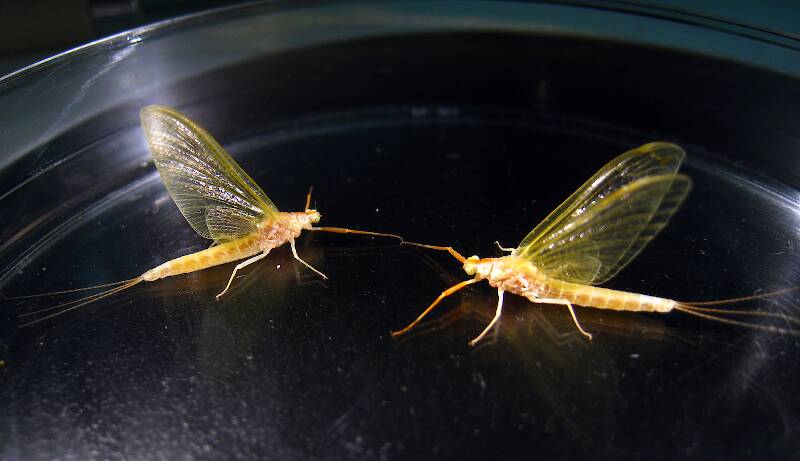
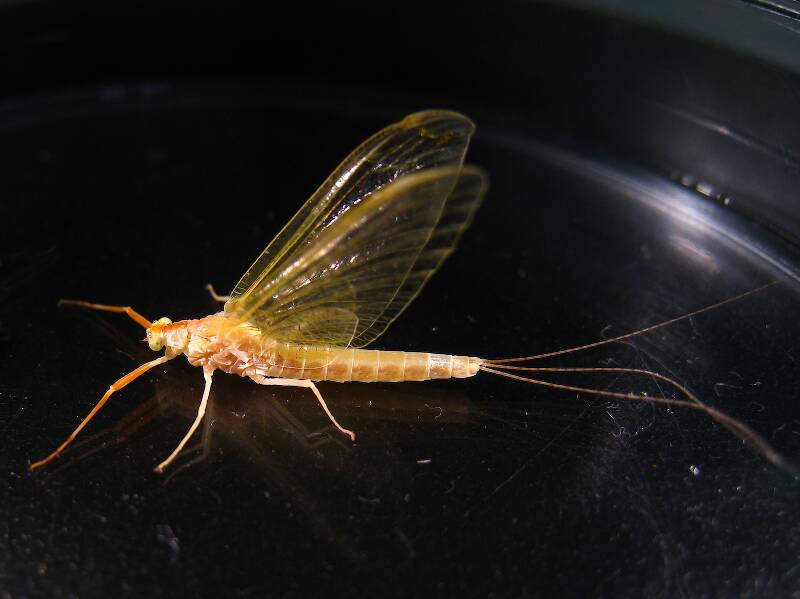
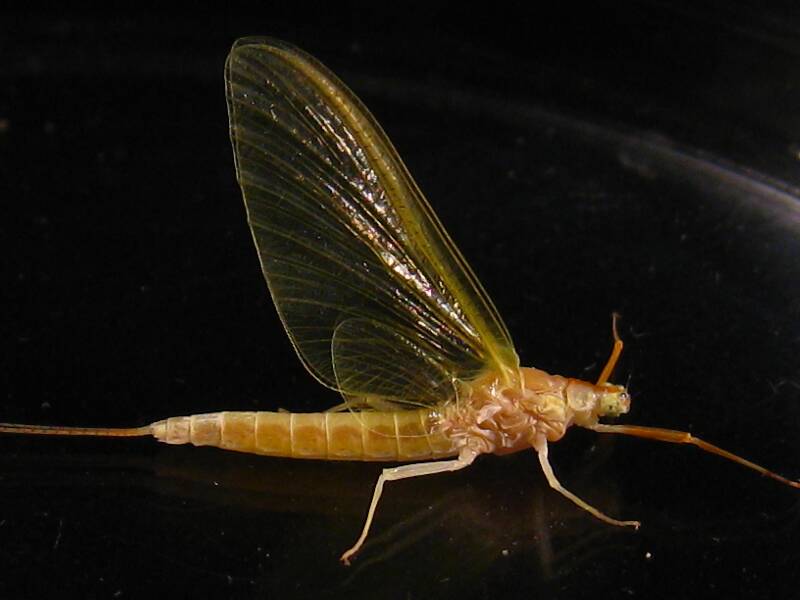
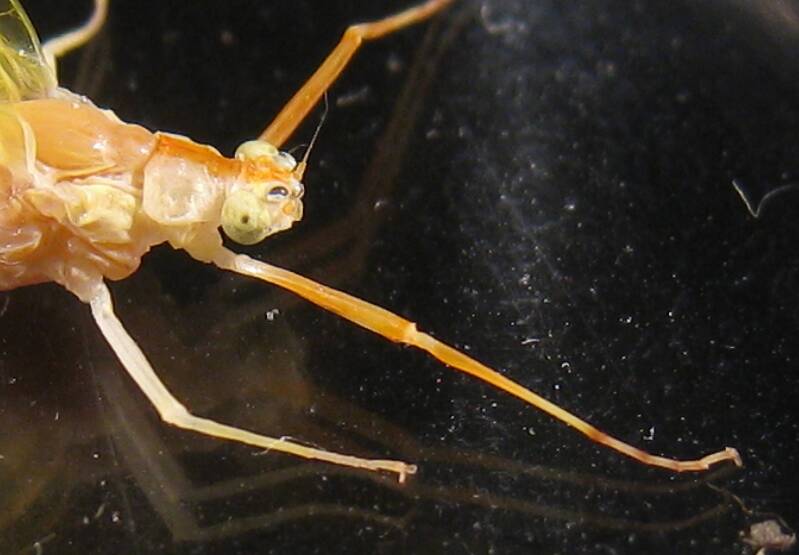
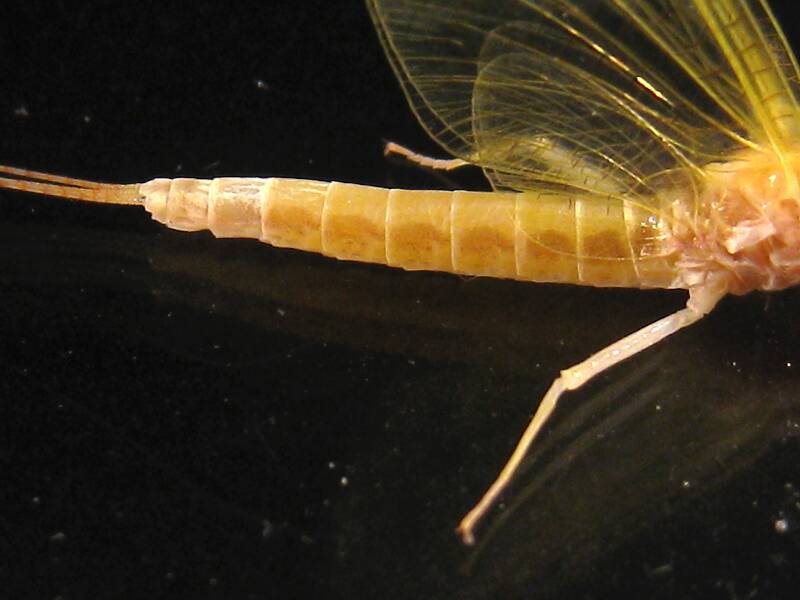
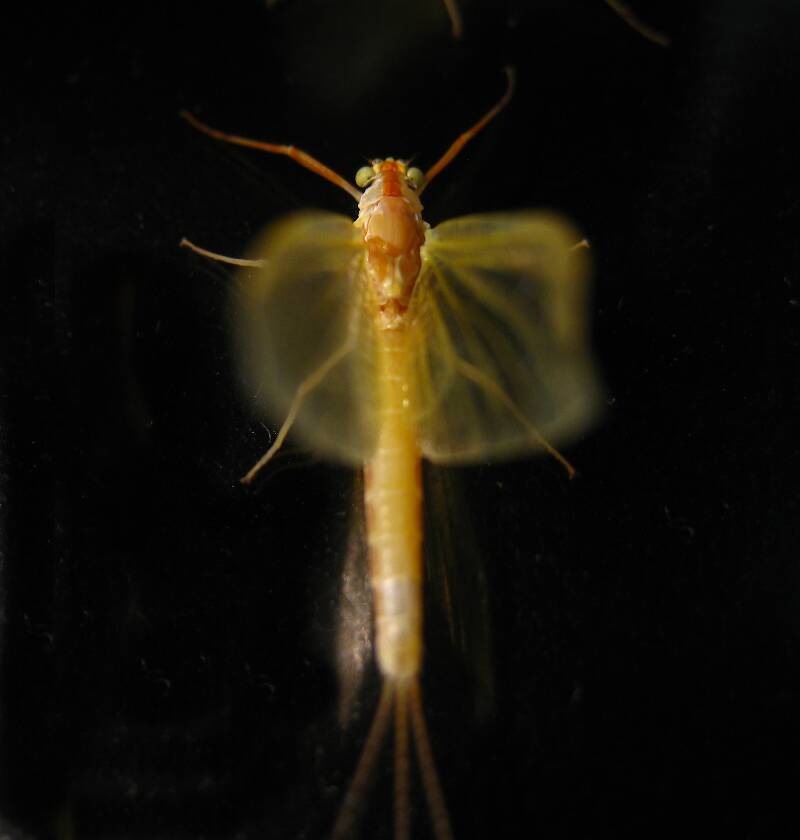
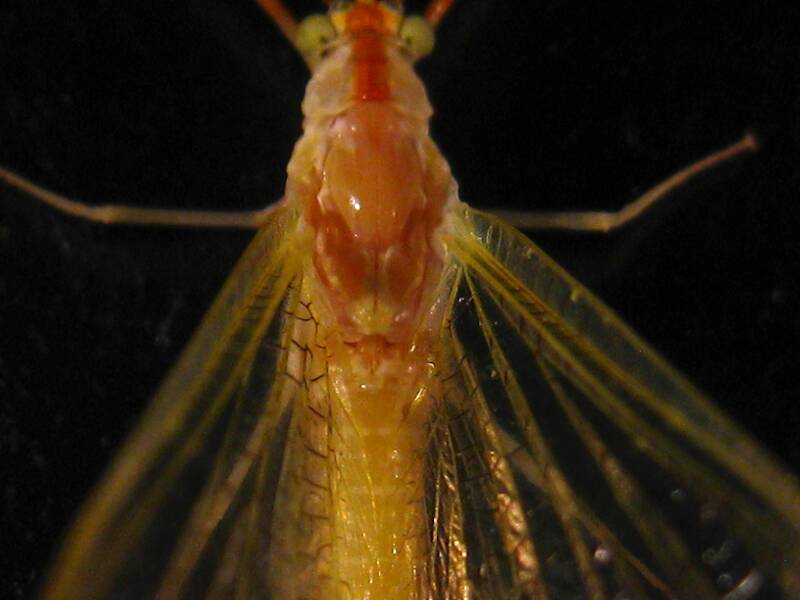
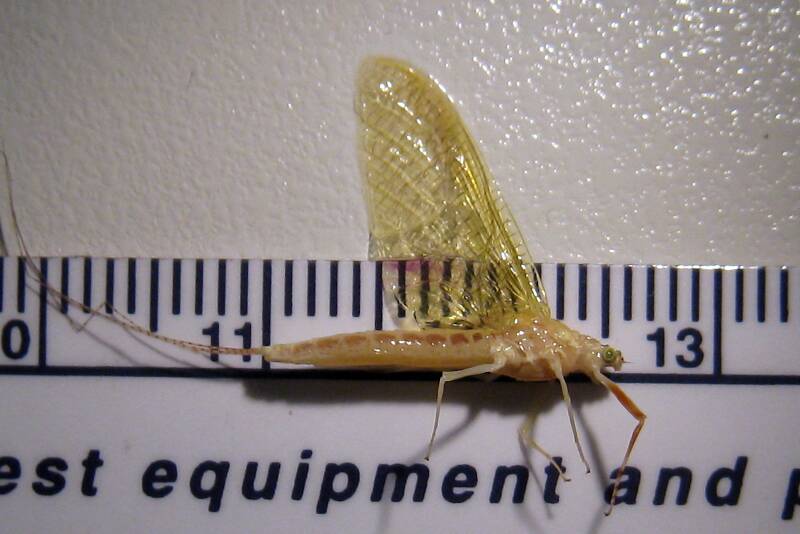
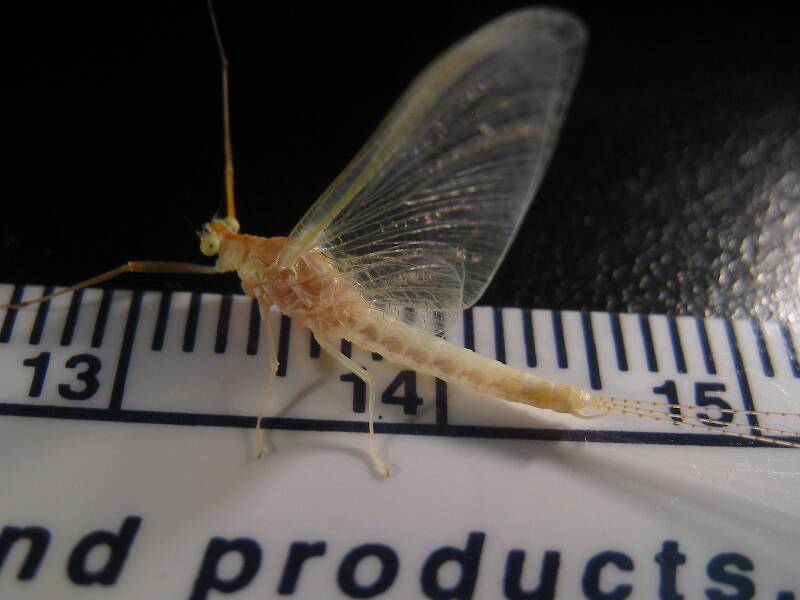
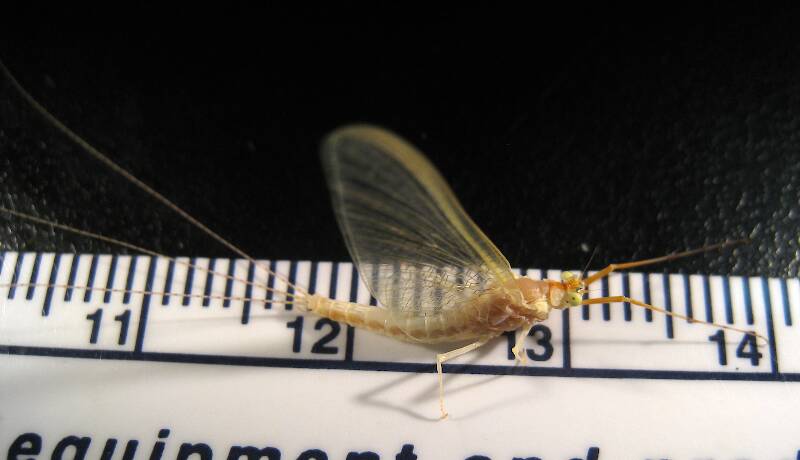
Crepuscular on Jun 14, 2012June 14th, 2012, 11:47 am EDT
Not the greatest photos but this is one of my most favorite mayflies. Quite a few on the Yellow Breeches right now.
Entoman on Jun 14, 2012June 14th, 2012, 12:41 pm EDT
The photos look pretty good to me, Eric! I agree with you that they are beautiful creatures.
The brown stripe on the vertex and pronotum coupled with the large rose colored spots looking like lateral stripes on the abdomen point to Anthopotamus distinctus (Golden Drake). These characters are quite "distinctive". :) The only other species with the brown stripe and dark cross veins lacks the large lateral spots and is a much smaller critter. I'm assuming these are well over 10mm. BTW - these are female imagos. Catch any males?
The brown stripe on the vertex and pronotum coupled with the large rose colored spots looking like lateral stripes on the abdomen point to Anthopotamus distinctus (Golden Drake). These characters are quite "distinctive". :) The only other species with the brown stripe and dark cross veins lacks the large lateral spots and is a much smaller critter. I'm assuming these are well over 10mm. BTW - these are female imagos. Catch any males?
"It's not that I find fishing so important, it's just that I find all other endeavors of Man equally unimportant... And not nearly as much fun!" Robert Traver, Anatomy of a Fisherman
Crepuscular on Jun 14, 2012June 14th, 2012, 1:39 pm EDT
Entoman on Jun 14, 2012June 14th, 2012, 1:57 pm EDT
Yes. Pale cross-veins and large lateral abdominal spots are found together on no other species in this genus. The only species it could be confused with is myops, which is much larger and has either a plain abdomen or barely discernible lateral markings. The larger eyes are also indicative of verticus. How big was he?
"It's not that I find fishing so important, it's just that I find all other endeavors of Man equally unimportant... And not nearly as much fun!" Robert Traver, Anatomy of a Fisherman
Crepuscular on Jun 14, 2012June 14th, 2012, 2:05 pm EDT
over 10mm probaly at least 12mm I have them in my office, i think, I can measure tomorrow if I can find them. My office looks like bomb went off in it right now...I thought myops and neglectus had the stripe too? Are they misidentified here: http://bugguide.net/node/view/126562/bgimage ? Is there a good key to species for them? I was going to ask you how you were differentiating distinctus from the other two. From the examples I've seen which are very few thhis one has a much more yellow tinge to the forewing than the other two, but that could be due to lighting etc.
Lastchance on Jun 14, 2012June 14th, 2012, 2:33 pm EDT
Hi All. Could I ask a favor? Would you also include the common name of these bugs when you post them? I ain't that smart.
Thanks,
Bruce
Thanks,
Bruce
Entoman on Jun 14, 2012June 14th, 2012, 2:52 pm EDT
Hi Bruce,
I did. You must have missed it filtering through all the descriptions and Latin!:) It's a great point you raise though, and I try to remember to put the common names in parenthesis next to the Latin. The problem is I usually only do it once at the names first mention because it gets too cumbersome to keep doing it through the rest of the thread.
BTW - all the species mentioned here are called Golden Drakes as well as a few other names.
I did. You must have missed it filtering through all the descriptions and Latin!:) It's a great point you raise though, and I try to remember to put the common names in parenthesis next to the Latin. The problem is I usually only do it once at the names first mention because it gets too cumbersome to keep doing it through the rest of the thread.
BTW - all the species mentioned here are called Golden Drakes as well as a few other names.
"It's not that I find fishing so important, it's just that I find all other endeavors of Man equally unimportant... And not nearly as much fun!" Robert Traver, Anatomy of a Fisherman
Entoman on Jun 14, 2012June 14th, 2012, 4:12 pm EDT
Eric -
Assuming you're talking about the head stripe, with neglectus yes, but this character is variable on myops.
No, both Taxon and Gonzo worked on the specimens in your link and I agree with their assessments. There was one left at the genus level that is neglectus, IMHO.
I'm primarily working with an old copy of The Mayflies of Illinois (Burks). Though it's old, the key and descriptions provided for these species are still valid as far as I know.
We mentioned three other species. Since I'm not sure which two you mean, I'll compare them all.:) A. neglectus is a much smaller critter and its spots aren't so large as to appear as stripes. Also, I don't believe it lives in PA. A. myops lacks the large lateral markings and has pale cross veins. When you capture some males, you should also find that their eyes are medium sized as opposed to the small ones those two species have. As for verticus, it is also a smaller species and lacks the head stripe. The males have very large eyes for the genus and unlike the females, the males have clear cross veins (or at most a few dark ones at the margins). Of the four, it is the only species that has differentiated cross vein color between the sexes.
Possibly, but this character is where the genus gets its common name. I believe it's too variable to be dependable for ID purposes.
Hope this helps. Very interesting animals, Eric. Thanks for posting them.
I thought myops and neglectus had the stripe too?
Assuming you're talking about the head stripe, with neglectus yes, but this character is variable on myops.
Are they misidentified here: http://bugguide.net/node/view/126562/bgimage ?
No, both Taxon and Gonzo worked on the specimens in your link and I agree with their assessments. There was one left at the genus level that is neglectus, IMHO.
Is there a good key to species for them?
I'm primarily working with an old copy of The Mayflies of Illinois (Burks). Though it's old, the key and descriptions provided for these species are still valid as far as I know.
I was going to ask you how you were differentiating distinctus from the other two.
We mentioned three other species. Since I'm not sure which two you mean, I'll compare them all.:) A. neglectus is a much smaller critter and its spots aren't so large as to appear as stripes. Also, I don't believe it lives in PA. A. myops lacks the large lateral markings and has pale cross veins. When you capture some males, you should also find that their eyes are medium sized as opposed to the small ones those two species have. As for verticus, it is also a smaller species and lacks the head stripe. The males have very large eyes for the genus and unlike the females, the males have clear cross veins (or at most a few dark ones at the margins). Of the four, it is the only species that has differentiated cross vein color between the sexes.
From the examples I've seen which are very few this one has a much more yellow tinge to the forewing than the other two, but that could be due to lighting etc.
Possibly, but this character is where the genus gets its common name. I believe it's too variable to be dependable for ID purposes.
Hope this helps. Very interesting animals, Eric. Thanks for posting them.
"It's not that I find fishing so important, it's just that I find all other endeavors of Man equally unimportant... And not nearly as much fun!" Robert Traver, Anatomy of a Fisherman
GONZO on Jun 14, 2012June 14th, 2012, 4:42 pm EDT
A. neglectus is a much smaller critter and its spots aren't so large as to appear as stripes. Also, I don't believe it lives in PA.
A. neglectus is a smaller critter, but it is found in PA. (Two subspecies comprise the current concept of A. neglectus, and PA seems as though it might be very near the heart of the range of A. neglectus neglectus).
Entoman on Jun 14, 2012June 14th, 2012, 7:50 pm EDT
Gonzo -
Hmm... That's good to know, thanks. I knew from reviewing Mayfly Central that n. disjunctus was more southerly while n. neglectus was the northeastern sibling, but for some reason Taxon's distribution charts show it missing from PA. I believe his chart is largely based on Distribution of Mayfly Species of North America (R. P. Randolph) for the eastern mayflies. Can you cite your source so that it can be edited?
Hmm... That's good to know, thanks. I knew from reviewing Mayfly Central that n. disjunctus was more southerly while n. neglectus was the northeastern sibling, but for some reason Taxon's distribution charts show it missing from PA. I believe his chart is largely based on Distribution of Mayfly Species of North America (R. P. Randolph) for the eastern mayflies. Can you cite your source so that it can be edited?
"It's not that I find fishing so important, it's just that I find all other endeavors of Man equally unimportant... And not nearly as much fun!" Robert Traver, Anatomy of a Fisherman
Martinlf on Jun 15, 2012June 15th, 2012, 4:24 am EDT
This is a new hatch for me. Any tips on fishing it?
"He spread them a yard and a half. 'And every one that got away is this big.'"
--Fred Chappell
--Fred Chappell
GONZO on Jun 15, 2012June 15th, 2012, 4:35 am EDT
Can you cite your source...?
Kurt, here are some sources in the scientific literature (the first one should already be familiar to you):
The Mayflies, or Ephemeroptera, of Illinois by Burks (1953)--"Known from Maryland, New York, and Pennsylvania" (pg. 32).
Phylogenetic Systematics of Potamanthidae (Ephemeroptera) by Bae and McCafferty (1991)--see distribution map on pg. 31.
Biodiversity of Mayflies (Ephemeroptera) of Pennsylvania by Hoover (2000)--this is a specimen-based report that is cited as a source for the Pennsylvania Aquatic Community Classification Project.
Crepuscular on Jun 15, 2012June 15th, 2012, 5:56 am EDT
I have added some photos of a male and a photo with a measured female.
Feathers5
Posts: 287
Posts: 287
Feathers5 on Jun 15, 2012June 15th, 2012, 7:15 am EDT
Hi Bruce,
I did. You must have missed it filtering through all the descriptions and Latin!:) It's a great point you raise though, and I try to remember to put the common names in parenthesis next to the Latin. The problem is I usually only do it once at the names first mention because it gets too cumbersome to keep doing it through the rest of the thread.
BTW - all the species mentioned here are called Golden Drakes as well as a few other names.
Oops! My mistake. Sorry!
Entoman on Jun 15, 2012June 15th, 2012, 9:23 am EDT
Gonzo -
Thanks for the citations. Especially pointing out the last sentence on the neglectus entry in Burks.:) Don't know how I missed that...
Eric - More great photos! I believe they confirm distinctus.
Thanks for the citations. Especially pointing out the last sentence on the neglectus entry in Burks.:) Don't know how I missed that...
Eric - More great photos! I believe they confirm distinctus.
"It's not that I find fishing so important, it's just that I find all other endeavors of Man equally unimportant... And not nearly as much fun!" Robert Traver, Anatomy of a Fisherman
Quick Reply
Related Discussions
Topic
Replies
Last Reply
0
Jul 3, 2006
by Troutnut
by Troutnut
4
Sep 27, 2014
by Millcreek
by Millcreek
3
Dec 10, 2015
by PaulRoberts
by PaulRoberts
10
Jun 21, 2014
by Johnvan61
by Johnvan61




